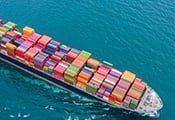Mandatory Port Adherence under the Touch and Stay Clause
In essence, the touch and stay clause dictate that the vessel, during its voyage, should make stops exclusively at the ports explicitly mentioned in the policy document. If a port is not specified in the policy, the vessel is obligated to follow the customary route and stay only at ports that naturally fall along its intended course. This requirement implies that the vessel must indeed touch and stay at all the ports as outlined in the policy document.
Moreover, it is essential to note that even if a deviation from the specified route occurs, the insurer would not consider it a non-deviation if this deviation did not increase the risk or if the ship was able to return to its prescribed course before any loss or damage took place. This aspect underscores the importance of adherence to the specified route.
Permissible Port Changes and Compliance with Multiple Ports
Situations may arise where the vessel needs to divert to a different port due to valid reasons, such as ensuring the safety of the ship or the lives of those on board. In such cases, the insurer may permit a change in ports and settle any subsequent claims. It is crucial to emphasize that this allowance for a change in port will be subject to the presentation of valid reasons by the policyholder.
Proving that such a change was necessary to safeguard both lives and cargo on board becomes the responsibility of the policyholder. In scenarios where the policy lists multiple ports, the vessel is obligated to touch and stay at all of them or, at the very least, at one of them as specified. Failure to comply with this condition, by not staying at a port mentioned in the policy document, may empower the marine insurance company to reject a claim in the event of loss or damage.
Learn more about Marine Insurance
Case Scenario
In the past, OceanVoy Logistics partnered with InnovateTech Engineering for Middle East exports. To protect against losses, they purchased marine insurance from HarborGuard Insurers. The policy specified approved ports for vessel stays, with any deviation potentially voiding coverage.
Using their joint venture vessel, AquaMech Express, to transport engineering goods, OceanVoy Logistics encountered technical issues and had to change ports. Damage occurred during unloading at the new port.
When OceanVoy Logistics sought an insurance claim, their request was denied by GlobalShield Underwriters, who conducted an investigation. It was determined that the port change lacked a valid reason, and coverage did not extend to losses at the new port.
OceanVoy Logistics argued technical issues forced the change, but the insurer emphasized the company's responsibility for ship maintenance and safety tests.
Since safety tests were not performed and the port change was not justified, the insurer refused to cover losses at the new port.
Conclusion
The Touch and Stay Clause in marine insurance policies plays a pivotal role in ensuring vessels adhere to specified routes and ports. Compliance with these provisions is paramount, as any deviation can jeopardize coverage. While valid reasons may allow for port changes, the burden of proof falls on the policyholder. The case of OceanVoy Logistics underscores the importance of adhering to safety protocols and policy specifications to prevent claim denials and ensure comprehensive coverage.





































 Expert advice made easy
Expert advice made easy


